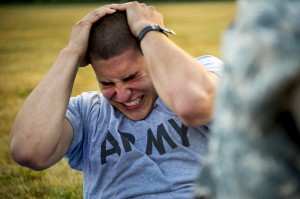 It might not be your fault. If you don’t like to exercise, or if the exercise you do doesn’t seem to count for much, there are reasons that have nothing to do with your discipline, your will, or your moral fiber. You are not a puss. It’s your DNA.
It might not be your fault. If you don’t like to exercise, or if the exercise you do doesn’t seem to count for much, there are reasons that have nothing to do with your discipline, your will, or your moral fiber. You are not a puss. It’s your DNA.
The Wall Street Journal recently ran a lengthy piece that details current research on attitudes toward exercise. You know the dichotomy. Some folks can’t seem to get enough; these are the gym rats who need to be reminded to get off the treadmill after a half hour. Others can’t start; they pay their monthly fees to a fitness club they don’t visit, which is a blessing for everyone who owns a fitness club and everyone who doesn’t want to wait for a treadmill.
Turns out about half of us are in the latter group: 52 percent of Baby Boomers report no physical activity. As in…whoa, it’s hard to grasp what that means. But that’s what most of us are (not) doing.
Why? The obvious answer is that we are repelled by pain, and that’s what exercise gives you.
Just how much of that pain can be traced to “genetic factors—things like lung capacity, oxygen transport and the rate at which oxygen is used in the muscle cells—is still a subject of scholarly debate.” It could be less than you think: by some estimates, it’s as low as 10 percent. But it could also be 50 percent.
Your current condition also plays a role: if you’re not in shape, you’ll quickly hit the point where you’re taking in less oxygen than the carbon dioxide you’re exhaling—the so-called “ventilatory threshold” which is “a sign that the muscles have become more acidic, which the body finds stressful.” Meaning you feel pain and your brain tells you to stop what you’re doing.
Both your ventilatory threshold and your maximum capacity for exertion can be slowly increased, but “people have to have enough positive experiences to stick with exercise over time so they actually can boost these limits.”
You can find that positive experience in many ways. Looking at pictures of green trees on your stationary bike helps. Or you could get on an actual bike and see actual green trees. Music makes it fun. Other people make it fun. You’re also smart to avoid activities that are frustrating: “Adults can be discouraged from exercising by not knowing what to do or how to do it. Those who were athletic in childhood may be frustrated by how their abilities have deteriorated over time.”
So don’t try to recapture the great fun you had as a high school middle linebacker. You should try something new. (And it probably shouldn’t be lacrosse.)
You don’t necessarily need good results—faster times, more shapely muscles, reduced weight, however you measure it—to have that good experience. A lot of people really enjoy sailing, and it’s a good day if you don’t get sunburned or have a hangover. You don’t ask for “good results” from enjoyable activities. But if there is some pain involved, good results seem like a fitting reward.
But here’s the bad news: exercise is not a meritocracy. Two people can do the same amount of work and one gets more reward. Again, blame it on your DNA.
To learn more about why it’s not your fault, check out “The Truth About Exercise,” one of the three parts in a PBS health series hosted by British author, journalist and TV person Michael Mosley. The episode (which premiered on April 10) included a segment in which Mosley saw the results from blood test that looked for markers of exercise responsiveness.
The news was not good: Mosley found out he was a non-responder to exercise. In fact, he had about the lowest score possible. He was laughing, but the “Bloody hell,” that slipped out was a pretty good indication of the frustration many people feel when exercise doesn’t…and won’t…pay dividends.
Do you want to have the facts that justify your flabby thighs? The British company XRGenomics is offering the non-responder test to citizens like you. And for additional details from the scientist featured in Mosley’s program—Prof. James Timmons—here’s his hour-long lecture on exercise.
Photo: Army Spc. Ahlam Gutierrez grimaces during the sit-up event during the 2012 U.S. Army Reserve Best Warrior Competition, by Sgt. 1st Class Mark Burrell via Wikimedia Commons.









